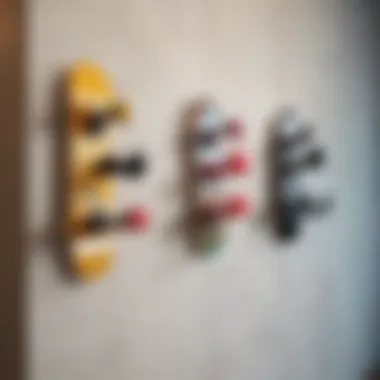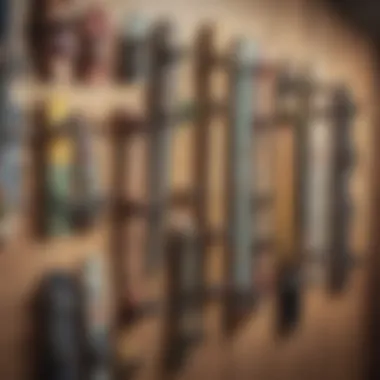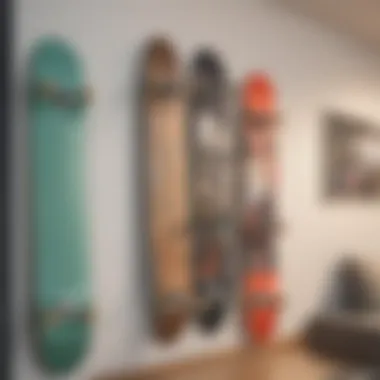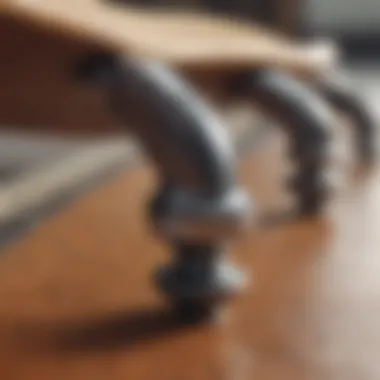Efficient Storage Solutions for Skateboards with Hooks


Intro
Skateboarding isn’t just a sport; it’s a lifestyle that weaves through the fabric of creativity, movement, and self-expression. As skateboards become an integral part of one's identity, proper storage solutions arise as both a necessity and an art form. There’s a fine line between preserving the board’s integrity and showcasing it as an element of decor. In this guide, we delve into the practical and aesthetic value of hooks designed to store skateboards. From understanding different types of materials to choosing the right design that complements your space, we aim to equip skateboard enthusiasts with innovative storage techniques that reflect their personal style.
Types of Hooks and Their Uses
When it comes to hanging skateboards, not all hooks are created equal. The right selection depends on factors like weight, design, and overall function. Here’s a quick overview:
- Wall-mounted hooks: These are versatile and can hold skateboards securely. They come in various designs, from minimalist to funky.
- Freestanding racks: Great for those who prefer not to drill into walls. They can be moved around easily and are perfect for rentals or temporary setups.
- Multi-board systems: Ideal for serious collectors, these hooks or racks allow multiple boards to be displayed without sacrificing space.
"A skateboard isn’t just a plank of wood; it��’s a canvas for art, a piece of history, and a tool for expression. Finding the right way to showcase it can change how you interact with it every day."
Materials to Consider
Selecting the right hooks requires understanding the materials involved. You’ll find a variety of options:
- Metal: Highly durable, metal hooks can hold significant weight and resist wear. Stainless steel or aluminum are common choices for longevity.
- Plastic: Lightweight and often more affordable, plastic hooks can be effective for occasional users or smaller boards, yet they may not withstand heavy use.
- Wood: Perfect for blending in with decor, wooden hooks offer a natural look and can be quite sturdy depending on their construction.
When assessing materials, think about how often you ride and how you wish to display your board. Heavy boards may benefit from robust metal hooks, while lighter, decorative boards might only require plastic or wooden options.
Aesthetic Considerations
Beyond functionality, the appearance of skateboard storage can make a statement in your space. Here are some ways to think about aesthetics:
- Color coordination: Match your hooks with the colors of your board or your room to create a seamless look.
- Design theme: Whether you lean towards modern minimalism or vintage warmth, there are hooks that fit with various decor styles.
- Personal expression: Don’t shy away from custom hooks that reflect your personality. From hand-painted designs to innovative shelving units shaped like skateboards, the sky is the limit.
Installation Tips
Once you’ve settled on the right hooks, the next step is to install them correctly. Here are a few tips:
- Always locate wall studs for heavy load support. This ensures your boards stay where you put them.
- Use appropriate anchors if you aren’t drilling into studs.
- Level your hooks before drilling; a crooked board isn’t just a looks issue but can lead to tipping.
Utilizing hooks to store skateboards transcends mere functionality. It integrates elements of personal style and spatial organization, reaffirming skateboarding's role as a crucial part of an individual’s identity. In the following sections, we will explore techniques, styles, and further insights into organizing skateboards, ensuring you not only store them effectively but also celebrate their uniqueness.
The Importance of Proper Skateboard Storage
Skateboarding is not just a hobby; it's a lifestyle that speaks to the very essence of individuality and freedom. But with that lifestyle comes the responsibility of caring for one's equipment. Proper skateboard storage is an often overlooked yet vital aspect for any skateboarder, whether they're a casual rider or a competitive athlete.
Preserving Board Integrity
Skateboards are crafted from layers of wood, often maple, which makes them both light and sturdy. However, improper storage can lead to warping, delamination, and other deterioration that compromise the board’s performance. Picture this: you've just bought a sleek new skateboard, only to toss it in a pile with the rest of your gear. Over time, that negligence could translate to a board that's not just less appealing, but also less rideable. By utilizing hooks to hang your boards, you prevent unnecessary pressure and damage.
Additionally, avoiding contact with the ground or other surfaces that can collect dust or moisture is critical.
Some key points include:
- Prevention of Warping: Keeping the board off the ground reduces the risk of warping from humidity.
- Protection from Impacts: When hung properly, the board isn't at risk of being knocked about, which can also lead to chips and cracks.
- Longevity: A well-cared-for board can last many years, making your investment worthwhile.
Maximizing Space Efficiency
For the urban skateboarder, space can often be at a premium. An organized storage system is more than just a convenience; it is essential for optimizing the available space in your home. When you utilize hooks for storage, every square inch can be effectively managed.
Consider the layout of your space: walls are often underutilized. By hanging skateboards, not only do you declutter the floor, but you also create a visually pleasing environment that reflects your passion.
Here are some practical benefits of smart storage:
- Creates Room for Other Gear: By verticalizing your storage, you have more room for other essentials like helmets, pads, and spare wheels.
- Quick Access: With boards neatly displayed, grabbing your gear for a quick session becomes a breeze.
- Aesthetic Appeal: A wall lined with boards can become a statement piece in your room, showcasing your style and personality.
In navigating the balance between function and form, it's crucial to prioritize how and where you store your skateboards. Hooks offer versatility and ease, transforming your space into a sanctuary for your skateboards, keeping them safe while enhancing the atmosphere.


Selecting the Right Hooks for Skateboards
Choosing the right hooks for skateboard storage is not just about function; it’s a blend of art and utility. Skateboards, often adorned with eye-catching graphics, can turn into an aesthetically pleasing component of your living space when hung properly. Using the right hooks ensures that your boards are safely stored while also giving you the opportunity to showcase your style. Whether you want to maximize space or find a striking way to display your collection, understanding the various types of hooks available is key.
Types of Hooks
Wall-mounted Hooks
Wall-mounted hooks are popular among skateboarders for their simplicity and effectiveness. These hooks usually attach directly to a wall, allowing for easy access and a clean presentation. One key characteristic of wall-mounted hooks is their ability to save floor space, making them ideal for smaller rooms or apartments.
One unique feature is that many wall-mounted hooks are designed with padding or rubber coatings, which prevent scratching and slipping. This precaution helps keep the board’s integrity intact, making it a great choice for frequent skaters who want to ensure their deck's graphic remains pristine. However, installation requires drilling into the wall, which might not be feasible for all renters.
Ceiling Hooks
Ceiling hooks offer a creative alternative for skateboard storage, particularly in spaces where vertical wall space is limited. Utilizing ceiling hooks keeps your boards off the floor and can create an interesting overhead display. Their high placement can make for a unique design statement.
The key characteristic of ceiling hooks is their versatility; most can hold multiple boards, doubling as a striking ceiling display. However, one downside is that accessing the boards may be a hassle, especially for taller ceilings. Therefore, it’s essential to accurately measure and consider the height before installation.
Freestanding Racks
If drilling into walls or ceilings isn’t suitable for your dwelling, freestanding racks could be your best bet. These racks can hold multiple skateboards in a compact footprint, making them great for busy households or communal spaces.
The most notable feature of freestanding racks is their mobility. You can rearrange or move them wherever you please—there’s no commitment with a permanent fixture. That said, they may take up more space than mounted solutions, and their stability varies depending on quality. Selecting a well-designed rack is crucial to prevent tipping or wobbling, particularly in lively environments.
Material Considerations
When it comes to hooks, the material they’re made of can significantly impact durability and functionality. Understanding the pros and cons of materials ensures that your skateboard hooks not only look good but also perform well and last long.
Metal
Metal hooks are often regarded as sturdy and reliable storage solutions. Their durability means they can hold heavier boards without bending or breaking. The key characteristic of metal is its weight-bearing capability, which is particularly essential for longboards or heavier skateboard setups.
One unique feature is that they often come with finishes like powder coating, which adds to their resistance against rust and wear. However, metal hooks can sometimes be pricier compared to other materials, and care must be taken to avoid scratching your board due to sharp edges, should they be present.
Plastic
Plastic hooks provide a more lightweight and cost-effective alternative to metal. They come in various colors and designs, making them a fun option for personal customization. The key characteristic of plastic hooks is their affordability, often making them an attractive choice for first-time buyers or casual users.
However, one downside might be their lower weight capacity. If you have a collection of heavier boards, ensure the hooks are rated for the load you need. Over time, some plastics may become brittle from exposure to sunlight, so be mindful of their placement.
Sustainable Options
In recent years, there has been a significant shift towards choosing sustainable materials for storage solutions. Options like bamboo or recycled plastics are gaining traction among eco-conscious skateboarders. The key characteristic of these sustainable solutions is their minimal environmental impact, making them an appealing choice for those looking to reduce their carbon footprint.
A unique feature of sustainable options often lies in their aesthetic appeal, embodying a natural look that can seamlessly blend into various environments. That said, they may come at a higher price point or require more diligent care to maintain their quality over time. Thinking ahead about sustainability adds value and aligns with a lifestyle of conscious consumption.
Installation Techniques for Skateboard Hooks
Effective installation techniques are vital when it comes to securing skateboard hooks, as improperly installed hooks can wreak havoc on your setup. The right approach ensures not just safety but also longevity for your boards. An accurate installation of skateboard hooks contributes significantly to maximizing wall space and showcases your boards beautifully, maintaining that artistic vibe that many skate enthusiasts cherish. Moreover, knowing how to assess wall integrity and perform a step-by-step installation can spare you the headache of failed attempts down the line, giving you confidence in your choices.
Assessing Wall Integrity
Stud Locations
Understanding stud locations is crucial when you're prepping to mount skateboard hooks. Studs are the vertical beams hidden behind your wall surface, offering the necessary support for heavier items. Locating these studs is generally the first step for any installation project. The key characteristic of studs is their ability to carry load effectively, making them an optimal choice when you wish to hang multiple skateboards without worries of stability.
One popular method for finding these locations is using a stud finder, however, a simple knock test or a measuring tape can do wonders too. The main advantage here lies in the stud's strength; they offer a steadfast grip that reduces any risks related to wall damage over time.
On the flip side, there are limitations; sometimes studs might not be spaced exactly where you expect them, which may suggest a need for alternate installation solutions. This discrepancy can steer you toward using wall anchors or alternatives, but utilizing studs whenever possible is still the best practice in providing an effectual mounting solution.


Drywall Considerations
When considering drywall, it's a different ball game entirely. Drywall itself poses unique challenges for those aiming to display skateboards. It is notably less sturdy compared to studs, demanding a more cautious approach. The key aspect here is recognizing that drywall can only hold a certain weight before crumbling under pressure, which directly affects your overall installation process.
A benefit of using drywall is its widespread availability and the ease of installation for hooks using drywall screws; however, failure to account for its fragility can lead to an array of pitfalls. Utilizing appropriate mounting hardware, such as toggle bolts or anchors, can expand the weight capacity but doesn't replace the need for careful planning.
The unique feature of drywall is its capacity to conceal cables and wires while providing an evening hang. Still, new skateboarders should tread softly. Excessive weight without proper reinforcements can end in loss—not only of your beloved gear but also to the wall itself.
Step-by-Step Installation Guide
This section will provide the tools and procedures needed to correctly install your skateboard hooks, emphasizing practicality and simplicity alongside aesthetic benefits.
Tools Required
You can’t build a solid foundation without the right tools. The tools needed for the installation of skateboard hooks are relatively straightforward. Common items like a drill, level, tape measure, and screwdriver should be in your toolbox. The key characteristic of these tools is their widespread use; even non-experts can feel at ease tackling the installation.
Using a level is particularly beneficial, as it ensures your hooks are aligned, avoiding any crooked placements that can look unattractive and unorganized. Missing out on the right tools can lead to a botched installation, potentially harming both your wall and your boards. Thus, having everything ready beforehand is a smart move.
Mounting Procedure
The actual mounting procedure blends a touch of technique with attention to detail. To begin, always mark your desired height on the wall, using pencil to note where the hooks will go. Next, drill pilot holes where needed, sticking to stud locations when possible to enhance stability.
A vital characteristic of the mounting procedure is the necessity of double-checking your work at each stage. Miscalculating a single measurement can result in uneven hooks, causing frustration that can easily be avoided. Once everything is secure, a quick adjustment might be necessary to align the hooks perfectly. The unique takeaway from this procedure is that careful attention to detail not only supports the weight but also enhances the overall aesthetic appearance of the display.
"The beauty of a well-installed hook lies in its simplicity. When planned and executed carefully, your skateboards become more than just gear; they transform into wall art."
In retrospect, proper electronic applications encourage both form and function, ultimately resulting in a cohesive setup that resonates with a skateboarder's identity. Mastering these techniques ensures your collection remains not only displayed but also treasured.
Creative Ways to Display Skateboards
Displaying skateboards creatively speaks volumes about one's personality and passion for the sport. It transcends mere storage, turning boards into eye-catching pieces of art. Not only does this add flair to your space, but it also highlights the importance of showcasing your boards in a way that reflects your individuality. Furthermore, a well-curated display can serve as inspiration, sparking creativity and joy every time you glance at it.
Artistic Arrangements
Color Coordination
Color coordination is about harmonizing hues to create a pleasing visual experience. This method has gained popularity because it effortlessly transforms the look of the display area. By selecting boards with complementary colors or arranging them in a gradient, you can turn a simple corner into a vibrant focal point. The key characteristic here is the eye for detail—onlookers are drawn not just to the boards but also to the overall aesthetic.
One unique feature of color coordination is its flexibility. Whether you opt for bold, bright colors or subdued, earthy tones, you can adapt your display to different styles. The advantages are clear: a coordinated setup can amplify a sense of unity while showcasing individual personalities. However, over-coordinating can sometimes stifle variety; striking a balance is key.
Board Orientation
The way your boards are oriented matters significantly. Horizontal displays can suggest stability, while vertical arrangements might exude a sense of movement and adrenaline, so they echo the skateboarding ethos. The notable aspect of board orientation is how it plays off available space. Many find vertical displays more space-efficient, letting you showcase multiple boards without overcrowding.
A unique characteristic of orientation lies in its impact on visibility. A horizontal layout may offer a broader view of graphic designs while vertical placements can add height and draw the eye upward. However, the downside to horizontal cases is that they can, at times, require more wall space. Both methods possess inherent advantages and disadvantages, and finding the right fit depends on your individual space and preference.
Incorporating Personal Style
Customization Ideas
Customization is a way to personalize your display. Adding your touch showcases not only your boards but also your journey within the skate world. You could paint the hooks, create custom mounts, or even include personal memorabilia alongside the boards. This distinct feature of customization lies in its ability to narrate a story, making your display uniquely yours.
This method's appeal is its versatility; there are no hard and fast rules. Some people may create themed arrangements that reflect specific skate trips or local parks, while others might favor a more abstract approach. However, be cautious about overdoing it—too many elements can clutter your display. The key is to represent your style while still allowing each board to shine in its own right.
Integrating Other Skate Gear
Integrating other skate gear with skateboard displays enhances the overall narrative of your storage solution. Helmets, protective gear, and even wheels can be arranged alongside boards to create cohesive stories about your skating experiences. This approach emphasizes not just the boards but the entire culture surrounding skateboarding.
The notable aspect of integrating other gear is the enrichment of context. You can create a scene from your favorite skate park or show the evolution of your gear over the years. Besides, this addition encourages conversations—friends and fellow skaters might pause to take in the whole picture. However, it’s essential to ensure that the focus remains on the skateboards, as overshadowing them with too many other items can lead to visual confusion. Striking the right balance between celebration and organization is crucial for a stunning display.


Curating a skateboard display is more than about protection; it’s an avenue for self-expression that merges functionality with creativity.
Maintaining Your Skateboard Display
To enjoy the vibrant world of skateboarding, one must consider the maintenance of their skateboard display. It goes beyond mere aesthetics; proper upkeep ensures that the boards remain in top shape while also reflecting the owner’s style and passion. An organized display not only looks better, but also keeps boards accessible for use. This section dives into the critical routine checks and adaptability measures necessary for preserving a functional and stylish skateboard setup.
Routine Checks
Inspecting Hooks for Stability
The first thing to keep in mind is the importance of checking hooks regularly. Stability can’t be taken lightly, especially when you’ve hung up your prized skateboards. Umstable hooks can lead to accidents and damage. Regularly inspecting these hooks allows you to ensure they can bear the weight of your boards properly. Many skateboard enthusiasts prefer metal hooks because they offer durability and can hold various board sizes with ease.
- Key Characteristic: Metal hooks typically provide a sense of reassurance due to their robust nature.
- Unique Feature: Unlike plastic options, metal hooks possess a greater resistance to wear over time, making them a popular choice for long-term storage.
- Advantages/Disadvantages: While metal is strong, it can scratch the board's finish if not padded properly. So, take a moment every few weeks to assess the integrity of your hook system.
Cleaning Boards Safely
Cleaning is another fundamental aspect of maintenance. While it may seem straightforward, cleaning your boards requires caution to avoid any mishaps. Using harsh chemicals can damage the artwork and graphics on your skateboard, so the focus should be on gentle methods. Warm water and a soft cloth can often do the trick, along with a mild soap.
- Key Characteristic: Safety in cleaning ensures the longevity of both the board and the display.
- Unique Feature: Gentle cleaning doesn't strip away the board's finish, unlike aggressive chemical cleansers.
- Advantages/Disadvantages: While it may take longer to clean without strong chemicals, the results will certainly maintain the visual integrity of your skateboard.
Adapting to New Acquisitions
As skateboarding evolves, so does one’s collection. Changing boards, new designs, and even different shapes can introduce challenges in how you display your collection. It’s essential to regularly update the display setup to accommodate any new pieces. You might need to readjust the hooks or even add more,
- Key Consideration: Always keep extra hooks or racks handy to adapt quickly when you come across that eye-catching board.
- Tip: If a new board is heavier, ensure that the hook or rack used is suitable for its weight.
In summary, maintaining your skateboard display requires diligence and a touch of personal flair. By taking the time to inspect hooks and clean the boards safely, while adapting to newly acquired pieces with thoughtful placement, you're not just preserving the boards but also curating a testament to your love for skateboarding.
Environmental Impacts of Storage Solutions
Understanding the environmental impacts of storage solutions is crucial for skateboard enthusiasts looking to make sustainable choices. As the skateboarding community continues to grow, the way we store and display our gear can either contribute to or mitigate environmental challenges. Choosing eco-friendly options can not only reflect our values but can also influence industry practices. By being mindful of our storage solutions, we can play a part in the larger conversation about environmental sustainability in the sports industry.
Choosing Sustainable Materials
When it comes to skateboard storage, the materials we use in hooks and racks matter quite a bit. Opting for sustainable materials means not only selecting components that are durable but also those that have a lower ecological footprint. Here are some sustainable choices:
- Bamboo: A fast-growing plant that is strong and lightweight. It's an excellent option that can hold skateboards without causing environmental harm.
- Recycled Metals: Using metals that have been recycled helps reduce the demand for new materials, significantly lowering resource extraction and pollution.
- Forest Stewardship Council (FSC) Certified Wood: If using wood for racks, ensure it's sourced from sustainable forests, verified by organizations like the FSC.
Using these materials can also improve the aesthetic of your storage while championing the environment at the same time. For example, a bamboo rack not only looks stylish but promotes a natural look in your living space, making it a win-win.
Waste Considerations in Production
From the moment we think about purchasing hooks or racks, it’s valuable to consider the waste generated during production. The skateboarding industry, like many others, faces challenges with manufacturing waste. Here’s what to think about:
- Production Methods: Some companies utilize more sustainable practices, like minimizing waste through smart design and manufacturing techniques. Understanding how a product is made can influence our buying decisions.
- End-of-Life Disposal: What happens to that hook or rack once it has served its purpose? Products made from sustainable materials are often easier to recycle, reducing landfill waste.
- Longevity: Investing in high-quality, durable products means you'll need replacements less frequently, thereby minimizing waste overall.
Considering these factors not only helps reduce the environmental footprint but also encourages manufacturers to adopt more sustainable practices. It’s all about making informed choices that align with personal values while promoting a healthier planet.
"In the world of skateboarding, our choices feed back into the community. If we prioritize sustainability, we elevate our culture as a whole."
By integrating sustainable practices into skateboard storage, we contribute to a greener future while elevating our passion for skateboarding. In the long run, every little effort counts and can create a ripple effect, inspiring fellow skaters to think twice about their storage solutions.
End
In summing up the various aspects of skateboard storage, it is clear that using hooks not only serves functional purposes but also lends an artistic touch to any space where skateboards are kept. This article has delved into multiple techniques and considerations surrounding hook usage, making it evident that the choice of storage solution can greatly impact both the boards' longevity and the overall aesthetic of a room.
First off, the emphasis on selecting the right hooks plays a crucial role in preserving the integrity of your boards. Each type of hook—from wall-mounted to ceiling-mounted—presents distinct advantages that can help maintain the shape and condition of the skateboards. For instance, wall-mounted hooks ensure that the boards are off the ground and away from dust, while ceiling hooks can save wall space, giving a unique three-dimensional display.
Next, we covered the importance of understanding material selection when it comes to hooks. Metal hooks may offer sturdiness and durability, but options made from sustainable materials are increasingly appealing for eco-conscious individuals. Opting for hooks crafted from recycled plastics or sustainable wood can align well with the mindset of caring about the environment—echoing broader cultural debates among skateboard enthusiasts.
You might also recall the installation techniques discussed. Knowing how to properly assess wall integrity avoids mishaps that could lead to damaged boards or even accidents. The step-by-step installation guide equips readers with the practical know-how needed to set up hooks securely, enhancing both safety and functionality.
Equally notable is the exploration of creative display ideas. Displaying skateboards offers an opportunity to showcase personal style and artistic flair. Eyeballing arrangements that incorporate color coordination and orientation can make a meaningful statement about the individual’s identity as a skater.
Moreover, maintaining the displayed skateboards is often overlooked but is integral to ensuring their longevity and visual appeal. Routine checks can prevent potential issues, making sure that both hooks and boards stay in good condition over time. This could save enthusiasts money in the long run as they work to preserve their beloved gear.
Lastly, embracing more sustainable storage solutions indicates a consciousness around environmental impact. A consideration of the lifecycle of materials used and a critical analysis of waste in production processes can help establish a more sustainable community among skateboarders. In an age where environmental concerns are at the forefront, it is vital to remember that every choice, no matter how small, contributes to a greater goal.



